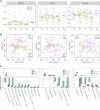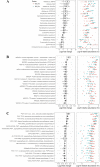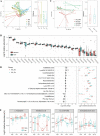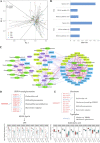Capsulized Fecal Microbiota Transplantation Induces Remission in Patients with Ulcerative Colitis by Gut Microbial Colonization and Metabolite Regulation
- PMID: 37093057
- PMCID: PMC10269780
- DOI: 10.1128/spectrum.04152-22
Capsulized Fecal Microbiota Transplantation Induces Remission in Patients with Ulcerative Colitis by Gut Microbial Colonization and Metabolite Regulation
Abstract
Fecal microbiota transplantation (FMT) can induce clinical remission in ulcerative colitis (UC) patients. Enemas, nasoduodenal tubes, and colonoscopies are the most common routes for FMT administration. However, there is a lack of definitive evidence regarding the effectiveness of capsulized FMT treatment in UC patients. In this study, we administered capsulized FMT to 22 patients with active UC to assess the efficiency of capsulized FMT and determine the specific bacteria and metabolite factors associated with the response to clinical remission. Our results showed that the use of capsulized FMT was successful in the treatment of UC patients. Capsulized FMT induced clinical remission and clinical response in 57.1% (12 of 21) and 76.2% (16 of 21) of UC patients, respectively. Gut bacterial richness was increased after FMT in patients who achieved remission. Patients in remission after FMT exhibited enrichment of Alistipes sp. and Odoribacter splanchnicus, along with increased levels of indolelactic acid. Patients who did not achieve remission exhibited enrichment of Escherichia coli and Klebsiella and increased levels of biosynthesis of 12,13-DiHOME (12,13-dihydroxy-9Z-octadecenoic acid) and lipopolysaccharides. Furthermore, we identified a relationship between specific bacteria and metabolites and the induction of remission in patients. These findings may provide new insights into FMT in UC treatment and provide reference information about therapeutic microbial manipulation of FMT to enhance its effects. (This study has been registered at ClinicalTrails.gov under registration no. NCT03426683). IMPORTANCE Fecal microbiota transplantation has been successfully used in patients. Recently, capsulized FMT was reported to induce a response in patients with UC. However, limited patients were enrolled in such studies, and the functional factors of capsulized FMT have not been reported in the remission of patients with UC. In this study, we prospectively recruited patients with UC to receive capsulized FMT. First, we found that capsulized FMT could induce clinical remission in 57.1% of patients and clinical response in 76.2% after 12 weeks, which was more acceptable. Second, we found a relationship between the decrease of opportunistic pathogen and lipopolysaccharide synthesis in patients in remission after capsulized FMT. We also identified an association between specific bacteria and metabolites and remission induction in patients after capsulized FMT. These findings put forward a possibility for patients to receive FMT at home and provide reference information about therapeutic microbial manipulation of FMT to enhance its effects.
Keywords: capsules; fecal microbiota transplantation; gut microbiome; metabolism; microbiome; ulcerative colitis.
Conflict of interest statement
The authors declare no conflict of interest.
Figures






Similar articles
-
Specific fungi associated with response to capsulized fecal microbiota transplantation in patients with active ulcerative colitis.Front Cell Infect Microbiol. 2023 Jan 5;12:1086885. doi: 10.3389/fcimb.2022.1086885. eCollection 2022. Front Cell Infect Microbiol. 2023. PMID: 36683707 Free PMC article. Clinical Trial.
-
Specific Bacteria and Metabolites Associated With Response to Fecal Microbiota Transplantation in Patients With Ulcerative Colitis.Gastroenterology. 2019 Apr;156(5):1440-1454.e2. doi: 10.1053/j.gastro.2018.12.001. Epub 2018 Dec 6. Gastroenterology. 2019. PMID: 30529583 Clinical Trial.
-
Long-term efficacy and safety of monotherapy with a single fresh fecal microbiota transplant for recurrent active ulcerative colitis: a prospective randomized pilot study.Microb Cell Fact. 2021 Jan 19;20(1):18. doi: 10.1186/s12934-021-01513-6. Microb Cell Fact. 2021. PMID: 33468164 Free PMC article. Clinical Trial.
-
Fecal transplantation for treatment of inflammatory bowel disease.Cochrane Database Syst Rev. 2018 Nov 13;11(11):CD012774. doi: 10.1002/14651858.CD012774.pub2. Cochrane Database Syst Rev. 2018. Update in: Cochrane Database Syst Rev. 2023 Apr 25;4:CD012774. doi: 10.1002/14651858.CD012774.pub3. PMID: 30480772 Free PMC article. Updated.
-
[Ulcerative colitis: Does the modulation of gut microbiota induce long-lasting remission?].Z Gastroenterol. 2019 Jul;57(7):834-842. doi: 10.1055/a-0874-6603. Epub 2019 Apr 15. Z Gastroenterol. 2019. PMID: 30986885 Review. German.
Cited by
-
Siderophore-harboring gut bacteria and fecal siderophore genes for predicting the responsiveness of fecal microbiota transplantation for active ulcerative colitis.J Transl Med. 2024 Jun 24;22(1):589. doi: 10.1186/s12967-024-05419-w. J Transl Med. 2024. PMID: 38915068 Free PMC article.
-
Exploring the Immunological Role of the Microbial Composition of the Appendix and the Associated Risks of Appendectomies.J Pers Med. 2025 Mar 14;15(3):112. doi: 10.3390/jpm15030112. J Pers Med. 2025. PMID: 40137428 Free PMC article. Review.
-
[Risk factors for malnutrition in ulcerative colitis complicated with pyoderma gangrenosum and construction of a lasso regression-based prediction model].Nan Fang Yi Ke Da Xue Xue Bao. 2025 Mar 20;45(3):514-521. doi: 10.12122/j.issn.1673-4254.2025.03.09. Nan Fang Yi Ke Da Xue Xue Bao. 2025. PMID: 40159966 Free PMC article. Chinese.
-
Gut microbiota and intestinal immunity interaction in ulcerative colitis and its application in treatment.Front Cell Infect Microbiol. 2025 Apr 9;15:1565082. doi: 10.3389/fcimb.2025.1565082. eCollection 2025. Front Cell Infect Microbiol. 2025. PMID: 40292216 Free PMC article. Review.
-
Intestinal Microbiota and Fecal Transplantation in Patients with Inflammatory Bowel Disease and Clostridioides difficile: An Updated Literature Review.J Clin Med. 2025 Jul 25;14(15):5260. doi: 10.3390/jcm14155260. J Clin Med. 2025. PMID: 40806882 Free PMC article. Review.
References
-
- van Nood E, Vrieze A, Nieuwdorp M, Fuentes S, Zoetendal EG, de Vos WM, Visser CE, Kuijper EJ, Bartelsman JFWM, Tijssen JGP, Speelman P, Dijkgraaf MGW, Keller JJ. 2013. Duodenal infusion of donor feces for recurrent Clostridium difficile. N Engl J Med 368:407–415. doi:10.1056/NEJMoa1205037. - DOI - PubMed
Publication types
MeSH terms
Associated data
LinkOut - more resources
Full Text Sources
Medical

